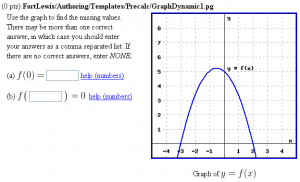Difference between revisions of "DynamicGraph1"
Paultpearson (talk | contribs) (PGML example link) |
(add historical tag and give links to newer problems.) |
||
| Line 1: | Line 1: | ||
| + | {{historical}} |
||
| + | |||
| + | <p style="font-size: 120%;font-weight:bold">This problem has been replaced with [https://openwebwork.github.io/pg-docs/sample-problems/Algebra/DynamicGraph.html a newer version of this problem]</p> |
||
| + | |||
| + | |||
<h2>Dynamically Generated Graph</h2> |
<h2>Dynamically Generated Graph</h2> |
||
Latest revision as of 06:03, 18 July 2023
This problem has been replaced with a newer version of this problem
Dynamically Generated Graph
This PG code shows how to create a dynamically generated graph with labels that is appropriately sized and positioned.
- File location in OPL: FortLewis/Authoring/Templates/Precalc/DynamicGraph1.pg
- PGML location in OPL: FortLewis/Authoring/Templates/Precalc/DynamicGraph1_PGML.pg
| PG problem file | Explanation |
|---|---|
|
Problem tagging: |
|
DOCUMENT(); loadMacros( "PGstandard.pl", "MathObjects.pl", "AnswerFormatHelp.pl", "PGgraphmacros.pl", "unionTables.pl", ); TEXT(beginproblem()); $refreshCachedImages = 1; |
Initialization:
Dynamically generated graphs require |
Context("Numeric");
$a = random(2,3,1); # left x-intercept
$b = random(2,4,2); # right x-intercept
$c = random(5,6,1); # y-intercept
$k = -($c)/($a * $b);
$A = $k;
$B = $k*($a - $b);
$C = -($k * $a * $b);
#
# Graph canvas
#
$gr = init_graph(-5,-1,5,9,axes=>[0,0],grid=>[10,10],size=>[300,300]);
$gr -> lb('reset');
#
# Graph labels and functions
#
$gr -> lb(new Label ( 4.5,0,'x','black','left','bottom'));
$gr -> lb(new Label ( 0.25,8.5,'y','black','left','bottom'));
$gr -> lb(new Label ( 0.25,$c,'y = f(x)','black','left','bottom'));
foreach my $i (1..4) {
$gr -> lb(new Label ( $i,-0.5, $i,'black','center','middle'));
$gr -> lb(new Label (-$i,-0.5,-$i,'black','center','middle'));
}
foreach my $j (1..8) {
$gr -> lb(new Label (-4.5,$j,$j,'black','center','middle'));
}
add_functions($gr, "$A*x**2+$B*x+$C for x in <-5,5> using color:blue and weight:2");
|
Setup:
For more details on the graph object |
Context()->texStrings;
BEGIN_TEXT
\{
ColumnTable(
"Use the graph to find the missing values.
There may be more than one correct answer,
in which case you should enter your answers
as a comma separated list. If there are no
correct answers, enter ${BITALIC}NONE.${EITALIC}
$BR
$BR
(a) \( f(0) = \) " .
ans_rule(7).$SPACE.
AnswerFormatHelp("numbers").
"$BR
$BR
(b) \( f \big( \) ".ans_rule(7)." \( \big) = 0 \). ".
AnswerFormatHelp("numbers")
,
image(insertGraph($gr), width=>300, height=>300, tex_size=>700).
$BR.$BCENTER.
$BR.
"Graph of \( y = f(x) \)".
$ECENTER
,
indent => 0, separation => 30, valign => "TOP"
)
\}
END_TEXT
Context()->normalStrings;
|
Main Text:
We use a two column format provided by
Using a Many existing questions generate image files with larger dimensions than necessary, but scale them down so as to be unreadable in HTML and PDF output, which makes them hard or impossible to use. If you have the time to make a graph, take the extra time to make it an appropriate size in both HTML and PDF output. |
$showPartialCorrectAnswers = 1; ANS(List($c)->cmp() ); ANS(List(-$a,$b)->cmp() ); |
Answer Evaluation: |
Context()->texStrings;
BEGIN_SOLUTION
${PAR}SOLUTION:${PAR}
Solution explanation goes here.
END_SOLUTION
Context()->normalStrings;
COMMENT('MathObject version.');
ENDDOCUMENT();
|
Solution: |
